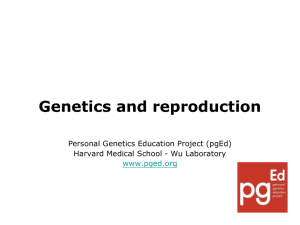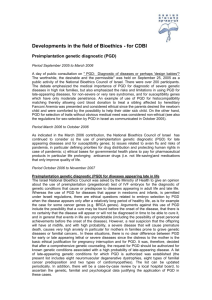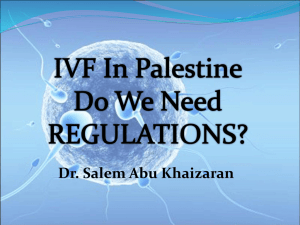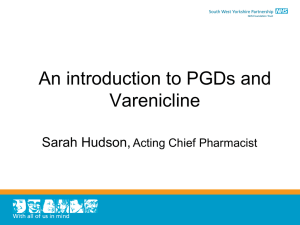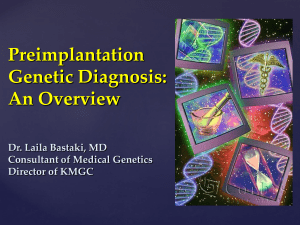Oseltamivir for pre and post exposure prophylaxis of avian
advertisement
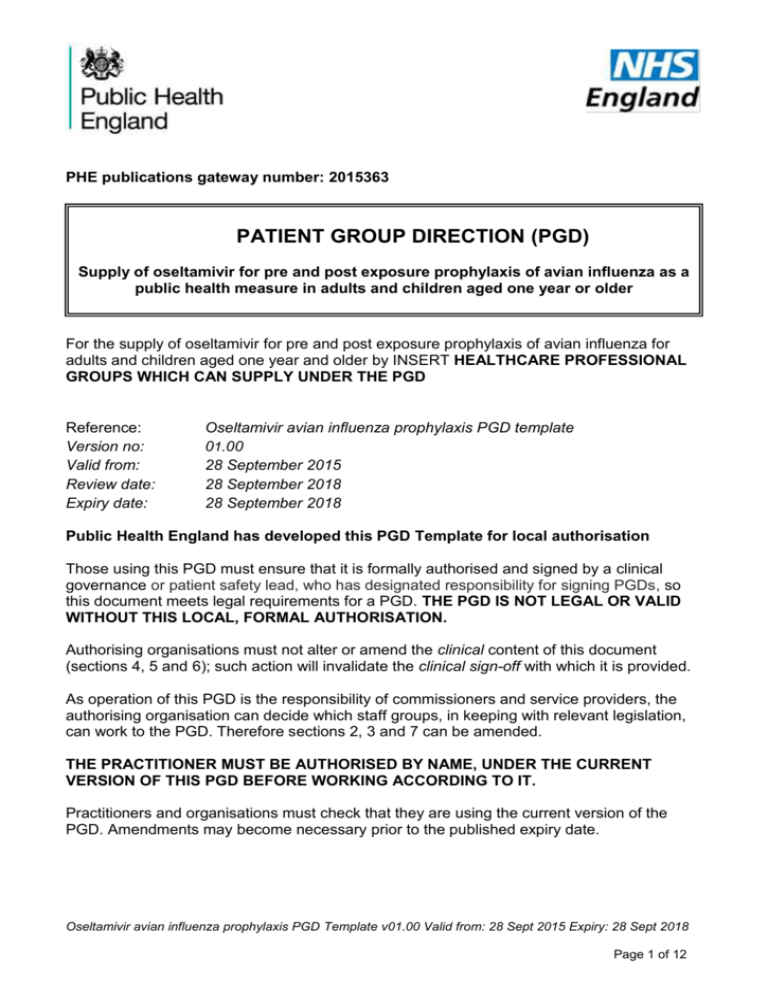
PHE publications gateway number: 2015363 PATIENT GROUP DIRECTION (PGD) Supply of oseltamivir for pre and post exposure prophylaxis of avian influenza as a public health measure in adults and children aged one year or older For the supply of oseltamivir for pre and post exposure prophylaxis of avian influenza for adults and children aged one year and older by INSERT HEALTHCARE PROFESSIONAL GROUPS WHICH CAN SUPPLY UNDER THE PGD Reference: Version no: Valid from: Review date: Expiry date: Oseltamivir avian influenza prophylaxis PGD template 01.00 28 September 2015 28 September 2018 28 September 2018 Public Health England has developed this PGD Template for local authorisation Those using this PGD must ensure that it is formally authorised and signed by a clinical governance or patient safety lead, who has designated responsibility for signing PGDs, so this document meets legal requirements for a PGD. THE PGD IS NOT LEGAL OR VALID WITHOUT THIS LOCAL, FORMAL AUTHORISATION. Authorising organisations must not alter or amend the clinical content of this document (sections 4, 5 and 6); such action will invalidate the clinical sign-off with which it is provided. As operation of this PGD is the responsibility of commissioners and service providers, the authorising organisation can decide which staff groups, in keeping with relevant legislation, can work to the PGD. Therefore sections 2, 3 and 7 can be amended. THE PRACTITIONER MUST BE AUTHORISED BY NAME, UNDER THE CURRENT VERSION OF THIS PGD BEFORE WORKING ACCORDING TO IT. Practitioners and organisations must check that they are using the current version of the PGD. Amendments may become necessary prior to the published expiry date. Oseltamivir avian influenza prophylaxis PGD Template v01.00 Valid from: 28 Sept 2015 Expiry: 28 Sept 2018 Page 1 of 12 Change history Version number Change details Date 01.00 Original PGD template 26 September 2015 Oseltamivir avian influenza prophylaxis PGD Template v01.00 Valid from: 1 August 2015 Expiry: 1 August 2018 Page 2 of 12 1. PGD template development This PGD template has been developed by the following on behalf of Public Health England: Developed by: Name Signature Pharmacist (Lead author) Jacqueline Lamberty Pharmacy and Medicines Management Lead PHE Date 23 August 2015 Dr John Astbury Doctor Consultant in Health Protection Health Protection Team Public Health England North West (Cumbria and Lancashire) 23 August 2015 Kate Brierley Registered nurse Acting Deputy Director – Health Protection Health Protection Team Public Health England North West (Cumbria and Lancashire) 23 August 2015 This PGD template has been peer reviewed by an Expert panel in accordance with the PHE PGD Policy. It has been agreed by the PHE Medicines Management Group and the PHE Clinical Governance Group. Expert panel Name Designation Professor Nick Phin (Chair) Director, Centre for Infectious Disease Surveillance and Control, National Infections Service, Public Health England Dr Gavin Dabrera Interim lead, Legionella and Influenza Preparedness and Response Section Susan McKernan Senior Medicines Performance Pharmacist Midlands and Lancashire CSU Oseltamivir avian influenza prophylaxis PGD Template v01.00 Valid from: 1 August 2015 Expiry: 1 August 2018 Page 3 of 12 2. Organisational authorisations The PGD is not legally valid until it has had the relevant organisational authorisation. It is the responsibility of the organisation that has legal authority to authorise the PGD, to ensure that all legal and governance requirements are met. The authorising body accepts governance responsibility for the appropriate use of the PGD. INSERT AUTHORISING BODY NAME authorise this PGD for use by the services or providers listed below: Authorised for use by the following organisations and/or services Limitations to authorisation eg Any local limitations the authorising organisation feels they need to apply in-line with the way services are commissioned locally. This organisation does not authorise the use of this PGD by …. Organisational approval (legal requirement) Role Name Sign Date Additional signatories according to locally agreed policy Role Name Sign Date Complete eg NHSE Governance Lead, Medical Director Organisations must add an individual practitioner authorisation sheet or list of authorised practitioners. This varies according to local policy but this should be a signature list or an individual agreement as included at the end of this PGD. Oseltamivir avian influenza prophylaxis PGD Template v01.00 Valid from: 1 August 2015 Expiry: 1 August 2018 Page 4 of 12 3. Characteristics of staff Qualifications and professional registration To be completed by the organisation authorising the PGD eg: Registered professional with one of the following bodies: Nurses currently registered with the Nursing and Midwifery Council (NMC). Pharmacists currently registered with the General Pharmaceutical Council (GPhC). Additional requirements Must be authorised by name as an approved practitioner under the current terms of this Patient Group Direction before working to it Must have undertaken appropriate training for working under PGDs for supply/administration of medicines Must be competent in the use of PGDs (see NICE Competency framework for health professionals using patient group directions). Must be familiar with the product and alert to changes in the Summary of Product Characteristics Have access to the Patient Group Direction and associated online resources. Should fulfil any additional requirements defined by local policy Insert any additional requirements THE PRACTITIONER MUST BE AUTHORISED BY NAME, UNDER THE CURRENT VERSION OF THIS PGD BEFORE WORKING ACCORDING TO IT. Continued training requirements Insert any continued training requirements Oseltamivir avian influenza prophylaxis PGD Template v01.00 Valid from: 1 August 2015 Expiry: 1 August 2018 Page 5 of 12 4. Clinical condition or situation to which this PGD applies. Clinical condition or situation to which this PGD applies Pre and post exposure prophylaxis of avian influenza as advised by Public Health England. Criteria for inclusion Adults and children (one year of age or older): Pre-exposure: individuals who will be handling or in close contact with live, sick, dying or dead birds infected or potentially infected with avian influenza (other than H7N9), or their bedding. Post-exposure: individuals who have handled or who have been in close contact with live, sick, dying or dead birds infected or potentially infected with avian influenza (other than H7N9), or their bedding, unless 7 days or more have elapsed since the last exposure. Criteria for exclusion1 Suspected or confirmed H7N9 influenza is not covered by this PGD as different doses are required Last exposure was more than 7 days previously Children aged under one year Individuals with a known allergy or hypersensitivity to oseltamivir or any of the excipients Individuals with moderate to severe renal disease (creatinine clearance ≤60mL/min) because a dose adjustment is required Immunocompromised individuals2 due to disease or treatment eg adults taking steroids at a dose equivalent to prednisolone ≥ 40 mg daily for more than one week; children receiving steroids equivalent to prednisolone orally or rectally of ≥ 2mg/kg/day for at least one week Individuals taking other drugs with clinically significant drug interactions eg chlorpropamide, methotrexate, phenylbutazone3 Action to be taken if the patient is excluded Some individuals excluded under this PGD may be suitable for post exposure prophylaxis if prescribed. Refer to a medical practitioner without delay. Action to be taken if the patient or carer declines treatment Cautions Advise the individual or carer of the possible consequences of refusing treatment and of alternative sources of treatment Advise about the protective effects of the treatment, risks of infection, risk of spreading the disease to others and disease complications. Document refusal and advice given in patient’s record Refer to a medical practitioner without delay. Refer individuals to a medical practitioner if: They exhibit sudden onset of symptoms of confusion, chest pain, breathing difficulties or any other symptoms giving cause for concern They have long term conditions such as chronic respiratory or cardiovascular disease exhibiting rapidly worsening symptoms 1 Exclusion under this Patient Group Direction does not necessarily mean the medication is contraindicated, but it would be outside its remit and another form of authorisation will be required 2 PHE guidance on use of antiviral agents for the treatment and prophylaxis of influenza (2014-15) 3 Refer to the Summary of Product Characteristics Oseltamivir avian influenza prophylaxis PGD Template v01.00 Valid from: 1 August 2015 Expiry: 1 August 2018 Page 6 of 12 5. Description of treatment Name, strength & formulation of drug Oseltamivir 75mg, 45mg and 30mg capsules Legal category POM - Prescription only medicine Black triangle No Off-label use Yes Guidance from Public Health England4 recommends chemoprophylaxis with oseltamivir as per the inclusion criteria Route / method of administration Oral Capsules should be swallowed whole with water. For individuals with swallowing difficulties, the capsules can be opened and the contents mixed with a small amount of sweetened food, such as honey, flavoured syrup or sugared water, just before administration (see Patient Information Leaflet). Dose and frequency of administration Adults and children aged 13 years and older: One 75mg capsule once a day, preferably in the morning with breakfast, for duration of treatment. Taking with food can reduce nausea or vomiting. For adults with a body weight less than 40 kg and children aged from 1 year to 12 years of age: refer to the table below5. Body Weight Dose, preferably in the morning with breakfast 10 kg to 15 kg 30 mg once daily > 15 kg to 23 kg 45 mg once daily > 23 kg to 40 kg 60 mg once daily > 40 kg 75 mg once daily If the child has a body weight less than 10 kg, refer to a medical practitioner. If the body weight cannot be determined and the child appears to be of average weight for their age use the following table6: Age Dose, preferably in the morning with breakfast, for 10 days 1 to 3 years 30 mg once daily 3 to 6 years 45 mg once daily 7 to 12 years 60 mg once daily Over 12 years 75 mg once daily Start the medication as soon as possible 4www.gov.uk/government/uploads/system/uploads/attachment_data/file/360265/occupationalguidanceforrespo nding20090101b.pdf 5 Doses taken from the SPC 6 Taken from the BNFc Oseltamivir avian influenza prophylaxis PGD Template v01.00 Valid from: 1 August 2015 Expiry: 1 August 2018 Page 7 of 12 Duration of treatment Minimum of 10 days All patients should receive treatment for 10 days following last known exposure. Individuals handling or in close contact with live, sick, dying or dead birds or their bedding need to receive treatment to cover the total exposure period and for 10 days following the last known exposure. Pre-exposure: if the individual is likely to have close contact in the future with live, sick, dying or dead birds or their bedding (eg as a responder to an avian influenza incident) they will need to receive treatment to start prior to the exposure, to cover the whole exposure period and for 10 days following the last known exposure. In these instances, the initial course will be 10 days. Once a worker has ended their exposure to the birds or their bedding, any remaining doses from the initial course should be properly disposed of. A new 10 day course should be issued to cover the 10 days after exposure ends. The maximum period of treatment that an individual can receive for a single incident through this PGD is 42 days. Public Health England should be contacted if an individual has already received 42 days of prophylaxis for a single incident but is being considered for further prophylaxis. Quantity to be supplied As above. Adults: Up to 10 x 75mg capsules per single issue Children: Body Weight Age Quantity of capsules to be supplied for 10 days treatment 10 kg to 15 kg 1 to 3 years 10 x 30 mg > 15 kg to 23 kg 3 to 6 years 10 x 45 mg > 23 kg to 40 kg 7 to 12 years 20 x 30 mg > 40 kg Over 12 years 10 x 75 mg Storage Do not store above 25oC Disposal Any unused product or waste material should be disposed of in accordance with local requirements. Drug interactions Patients taking the following medicines are excluded from this PGD: Identification & management of adverse reactions (continued on Page 9) Chlorpropamide Methotrexate Phenylbutazone Frequently reported adverse reactions include nausea, vomiting, abdominal pain and dyspepsia These reactions may only occur on a single occasion, on either the first or second treatment day, and resolve spontaneously within 1-2 days. However, if symptoms persist patients should consult a healthcare professional. Patients should be advised not to discontinue treatment without consulting a doctor or pharmacist Other commonly reported adverse reactions include bronchitis, Oseltamivir avian influenza prophylaxis PGD Template v01.00 Valid from: 1 August 2015 Expiry: 1 August 2018 Page 8 of 12 Identification & management of adverse reactions dizziness (including vertigo), fatigue, headache, insomnia, herpes simplex, nasopharyngitis, upper respiratory tract infections, sinusitis, cough, sore throat, pyrexia, rhinorrhoea, pain including limb pain. (continued) A detailed list of adverse reactions is available in the Summary of Product Characteristics, which is available from the electronic Medicines Compendium website: www.medicines.org.uk Reporting procedure of adverse reactions Any adverse reaction to the product should be documented in the medical records Alert a doctor in the event of serious adverse reaction Report suspected adverse reactions to the Medicines and Healthcare products Regulatory Agency (MHRA) using the Yellow Card reporting scheme on: http://yellowcard.mhra.gov.uk Written information to be given to patient or carer Supply the marketing authorisation holder's patient information leaflet (PIL) Patient advice /follow up treatment Advise the individual or their carer: Each individual should be given a copy of the PHE information for contact of avian influenza Records (continued on Page 10) that taking the medication with a small amount of food can reduce nausea or vomiting that the capsules can be opened and taken with a small amount of sweetened food as explained in the PIL of any possible side effects and their management to seek medical advice in the event of a severe adverse reaction to seek advice if common side effects do not spontaneously resolve 48 hours after they first appear that the patient should complete the course to read the PIL leaflet before taking the medication explain that the PIL does not mention avian influenza because the manufacturers have not sought a product license for this indication, but PHE recommends the use of this medicine in these circumstances and it is deemed best practice to seek medical advice if they experience influenza symptoms within 7 days Record: Whether valid informed consent was given Name of patient, address, date of birth and GP with whom the patient is registered Name of member of staff who administered the product Name and brand of product Date of administration Dose, form and route of administration of product Quantity administered Batch number and expiry date Advice given; including advice given if excluded or declines treatment Details of any adverse drug reactions and actions taken Record supplied via Patient Group Direction (PGD) Oseltamivir avian influenza prophylaxis PGD Template v01.00 Valid from: 1 August 2015 Expiry: 1 August 2018 Page 9 of 12 Records should be signed and dated Records (continued) All records should be clear, legible and contemporaneous. A record of all individuals receiving treatment under this Patient Group Direction should also be kept for audit purposes in accordance with local policy. Oseltamivir avian influenza prophylaxis PGD Template v01.00 Valid from: 1 August 2015 Expiry: 1 August 2018 Page 10 of 12 6. Key references Key references Summary of Product Characteristics www.medicines.org.uk PHE Avian influenza: guidance, data and analysis August 2014 www.gov.uk/government/collections/avian-influenza-guidancedata-and-analysis Occupational guidance for those responding to a suspected or confirmed avian influenza incident www.gov.uk/government/uploads/system/uploads/attachment_data /file/360265/occupationalguidanceforresponding20090101b.pdf PHE guidance on use of antiviral agents for the treatment and prophylaxis of influenza (2014-15) Version 5.1, January 2015 https://www.gov.uk/government/uploads/system/uploads/attachme nt_data/file/400392/PHE_guidance_antivirals_influenza_201415_5_1.pdf British National Formulary (BNF) https://www.medicinescomplete.com/mc/bnf/current/ British National Formulary for children (BNFc) www.medicinescomplete.com/mc/bnfc/2011/ NICE Medicines Practice Guideline 2 (MPG2): Patient Group Directions https://www.nice.org.uk/guidance/mpg2 NICE MPG2 Patient group directions: competency framework for health professionals using patient group directions https://www.nice.org.uk/guidance/mpg2/resources/mpg2-patientgroup-directions7 Health Technical Memorandum 07-01: Safe Management of Healthcare Waste. Department of Health 20th March 2013 https://www.gov.uk/government/publications/guidance-on-the-safemanagement-of-healthcare-waste Oseltamivir avian influenza prophylaxis PGD Template v01.00 Valid from: 1 August 2015 Expiry: 1 August 2018 Page 11 of 12 7. Individual practitioner authorisation sheet BY SIGNING THIS PATIENT GROUP DIRECTION YOU ARE INDICATING THAT YOU AGREE TO ITS CONTENTS AND THAT YOU WILL WORK WITHIN IT PATIENT GROUP DIRECTIONS DO NOT REMOVE INHERENT PROFESSIONAL OBLIGATIONS OR ACCOUNTABILITY IT IS THE RESPONSIBILITY OF EACH PROFESSIONAL TO PRACTISE ONLY WITHIN THE BOUNDS OF THEIR OWN COMPETENCE Practitioner I confirm that I have read and understood the content of this Patient Group Direction and that I am willing and competent to work to it within my professional code of conduct Signed……………………………….………………………….…..Date……….….………….............. Name (Print)…………….…………..………….………………………………………….……............. Designation……………………………………………………………….…..………………................ Authorising manager Manager to give authorisation on behalf of INSERT NAME OF ORGANISATION for the named healthcare professional who has signed the PGD Signed…………………………………….………………………. Date……………………….......... Name (Print)………………………..…………………………………….……………..……….......... Designation………………………………………………………………..…………….……............. Note to authorising manager By signing above you are confirming that you have assessed the staff member as competent to work under this PGD and that they have the organisational approval to do so You must give this signed PGD to each authorised practitioner as it shows their authorisation to use the PGD Oseltamivir avian influenza prophylaxis PGD Template v01.00 Valid from: 1 August 2015 Expiry: 1 August 2018 Page 12 of 12
